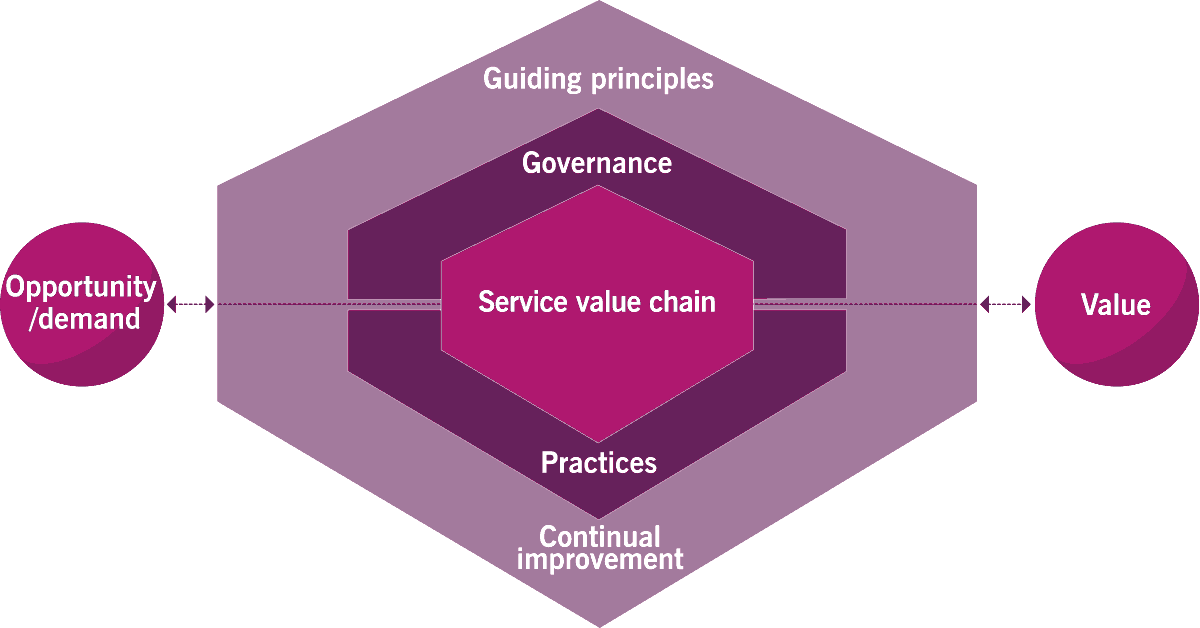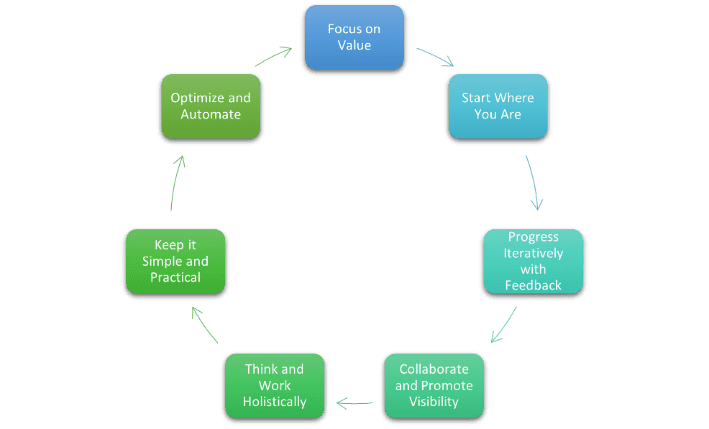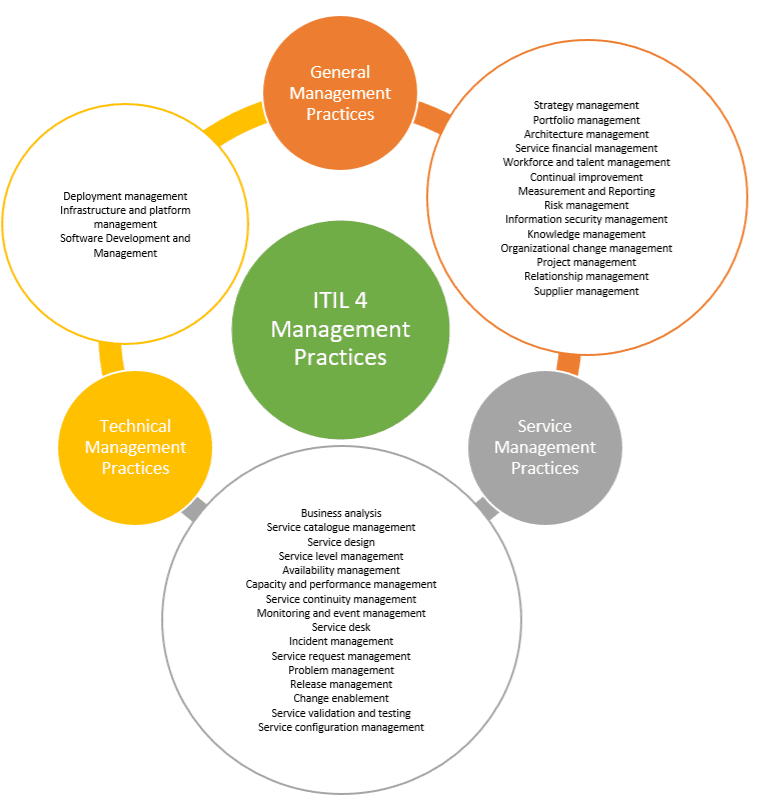Understanding the ITIL 4 Management Practices
10 mins read
Driving Success in IT Service Delivery
ITIL practices are widely recognized and used in various industries around the world. They provide a systematic and professional approach to IT service delivery. They help organizations manage risk, establish cost-effective practices, strengthen customer relations, and build a stable IT environment for growth, scale, and change.
At the heart of the ITIL 4 framework is a set of management practices that help organizations navigate and deliver value.
ITIL Overview and the ITIL Framework Explained
ITIL is a set of best practices for IT service management (ITSM) focused on delivering value through a service value system, seven guiding principles, and 34 management practices.
The ITIL management practices help divide these 34 management practices into the functional areas they represent:
- General management practices
- Service management practices
- Technical management practices
These practices support the governance models and best practices of the service value system, which defines how the resources and activities of an organization come together to facilitate value for the organization.
The service value chain starts with stakeholder engagement to define an opportunity or business demand for new/changed services and then produces value through activities that deliver that service.

ITIL's 7 Guiding Principles
Organizations can start their ITIL adoption program by using a set of established principles as a basis for driving the cultural change needed for success.

The 7 Guiding Principles provide an approach that can be adapted to an organization's needs and enable IT to deliver high-value services by operating efficiently and effectively.
These principles begin with a focus on value and an emphasis on starting with the current state. Starting where you are means assessing currently adopted best practices, determining which are effective, and then iterating and improving the management practices.
When adopting the ITIL management practices, the seven guiding principles enable organizations to assess their current practice and then work iteratively to build and improve the practice, using feedback and collaboration throughout the process.
The benefit of ITIL's 7 Guiding Principles is that they are universal: they can be used by business partners outside IT and in any organization of any size or industry vertical.
ITIL 4 Dimensions
Focusing on ITIL's four dimensions ensures organizations can develop management practices that operate outside of their silo. The four dimensions include:
- Organizations and people
- Information and technology
- Partners and suppliers
- Value streams and processes.
As management practices are adopted, ensuring they address and understand the impact of the practice on all four of these areas is critical.
|
Organizations and People |
This dimension focuses on defining roles and responsibilities, along with their skills and the overarching organizational structure. This focus ensures the impact of practices on the professionals working in the organization is considered, along with their training needs. |
|
Information and Technology |
Focuses on ensuring the knowledge and information needed to support technology are available to the people who need it. This area also includes consideration of tools and data required to deliver services effectively. |
|
Partners and Suppliers |
This dimension focuses on effectively sourcing services and offers a structure for evaluating and managing suppliers, ensuring the most cost-effective options are considered for service design and delivery. |
|
Value Streams and Processes |
Understanding the value of processes and ensuring they are right-sized and well-designed is a critical aspect of management practices. This dimension offers the link to management practices, providing an understanding of the organization's value streams and how processes support them. |
ITIL 4 Management Practices
The ITIL 4 value system leverages 34 management practices derived from the 26 processes defined in the ITIL Service Lifecycle from ITIL v3. Rather than grouping them into the former ITIL Service Lifecycle approach of ITIL Service Strategy, ITIL Service Design, ITIL Service Transition, ITIL Service Operations, and Continual Service Improvement, ITIL 4 groups them into three practice areas, as shown in the diagram below:

Used in conjunction with the service value system architecture, these management practices enable organizations to build an operating model that crosses departmental silos, encouraging business units, including IT, to work together towards delivering value.
Each of the ITIL 4 management practices uses a set of standard terms to offer defined processes, guidance on the roles involved in the practice's delivery, key activities, and success factors. Documentation for each practice should include its objectives, policies, procedures, and critical success factors. The success factors can be further documented as ITIL KPIs, enabling organizations to measure their effectiveness and continuously improve their practices.
General Management Practices
These practices are adopted from general business management capabilities and involve a cross-section of stakeholders from business units and IT, ensuring that service delivery meets the needs of the business units and produces the anticipated value.
Responsibility for some of these practices may be spread across the organization. For example, workforce and talent management is commonly part of Human Resources, and the Legal department frequently handles risk management.
Virtually every one of the general management practices could be performed outside of IT for business needs that don't involve technology or across the organization to deliver technology-based services. Even information security management, while it sounds like an IT function, carries a component unrelated to technology, such as the physical storage and security of financial instruments, customer records, and other paperwork.
Service Management Practices
The service management practices cover ground familiar to many IT professionals as they have been part of service management initiatives for many years. Practices like incident management, change enablement, and service level management are embedded in most organizations as common ways of doing business.
The service management practices include essential aspects of ITIL service design, focusing on warranty and utility. This objective ensures that services are designed to fit the purpose needed by the business with functionality that meets their intended objectives and offers the expected availability and performance.
They also focus on ITIL service operations needs, covering the service desk function and associated practices like service level management and service request management, frequently used by the service desk.
Service management practices like problem management and configuration management help IT operate proactively by documenting service configuration and understanding and addressing the root cause of incidents.
Many service management practices evolved from the ITIL v3 processes from the ITIL Service Design, ITIL Service Transition, and ITIL Service Operation portions of the ITIL lifecycle.
Technical Management Practices
Infrastructure operations and application development fall into the technical management practices, ensuring the technical aspects of service delivery are considered. In addition to infrastructure and platform management practices and software development and management, deployment management is a standardized practice to ensure the successful introduction of new services and changes to existing services.
Ensuring Service Delivery
While ITIL management practices form a critical foundation for ensuring delivery of the service value chain, without leadership and improvement, they become stagnant and deteriorate in their effectiveness.
The ITIL Strategic Leader
A strategic leader engages other business leaders to understand their needs and helps provide a clear understanding of how technology supports and drives business strategy. They also work with other professionals to create an agile and resilient business culture that can withstand industry changes and cyber threats using digital innovations.
The ITIL Strategic Leader indicates that an IT professional has achieved advanced training in the ITIL framework, including understanding how IT can influence and deliver business strategy. Only people with management experience can obtain this certification.
ITIL Metrics and KPIs
In ITIL, metrics and key performance indicators (KPIs) are essential for measuring the effectiveness and efficiency of IT services. They help track compliance, performance, and improvement in the ITIL management practices and indicate areas that need improvement.
An effective strategic leader will use metrics to evaluate their teams' ability to deliver value through services, moving away from more subjective approaches. When a new service is being designed, critical success factors are identified and tied to KPIs that indicate the value of the service when it is effectively operated and used.
The Business Value of the ITIL Management Practices
The ITIL management practices enable IT strategically and operationally, ensuring value is delivered. The use of these practices positively impacts several key areas:
Service Delivery:
When an organization encounters an issue with the performance of a particular application, it can use several service management and technical management practices to address customer complaints:
- The problem management practice is leveraged to document the issue. Problem management practitioners will gather application and technical management team members to investigate.
- Application and Technical Management practices then investigate the potential connectivity issues, hardware, and application changes that might have slowed performance.
- Capacity Management can also be used to determine if the issue is growth-related.
- Problem Management processes would be used to govern who should be engaged throughout the discovery and troubleshooting phase and then would engage with other practice areas like Change Enablement and Release Management when a solution is found.
Customer Satisfaction
ITIL management practices are also helpful when IT receives complaints from customers who feel their services aren't meeting business needs.
- The continual service improvement practice could be leveraged to document and investigate the complaints, working with key business stakeholders to create a service improvement plan based on customer feedback.
- The service improvement plan would then lay out other management practices that could be useful in improving the service: availability management to improve the service's stability and performance and service level management to address resolution timeframes that don't meet the customer's needs, for example.
- Management and reporting capabilities could be used to establish the critical success factors and key performance indicators that would bring the service to a satisfactory level and then report on the results of the general improvement program.
Cost Reduction and Resource Optimization (both people and technology)
While IT often hears "do more with less," ITIL4 has management practices that help address cost-effective operations:
- The financial management and contract management practices provide a starting point for understanding high-cost services' total cost of operation and look for opportunities to reduce costs, including contract reviews.
- Workforce and talent management can help analyze staffing levels and help with changes to balance staff for more effective operations, using training to re-skill workers from overstaffed areas and reassign them to short-staffed departments.
Risk Management and Compliance
When legal changes in the like data privacy regulations occur, several ITIL 4 management practices could become involved in managing the changes:
- The portfolio management practice would direct the need to change services in the service portfolio, engaging teams to evaluate the application changes needed.
- The general management practices of risk management and supplier management would support a full risk assessment and contract review to identify risks associated with the change.
- The Information Security Management practice would help ensure security needs are included in the review, and application management would then drive any application changes needed to comply with the new regulations.
- Organizational change management and knowledge management would ensure the people interacting with customer data are aware of the legal change and application changes.
Agility and Flexibility
The standard operating model created by using the ITIL 4 management practices provides a competitive edge to businesses by providing them the agility to respond to external changes quickly and effectively, enabling them to operate cost-effectively while maintaining high customer satisfaction.
They also enable organizations to eliminate waste by developing standard approaches to repeatable tasks, which can be measured, improved, and automated to scale delivery.
ITIL 4's focus is on driving business value. The service value system and guiding principles lay a solid foundation for engaging customers and adopting ITIL. They can help organizations shift from daily operations to build a strategic approach to service management and help shift an internal IT focus to an external business focus.
Organizations also need a strong operating model to make daily work repeatable and reliable to achieve excellence. The management practices provide the ability to create operating models as needed within IT for managing the technical environment and across the business for broader operational needs. Gaining mastery of the ITIL 4 management practices enables organizations to excel operationally and strategically.

